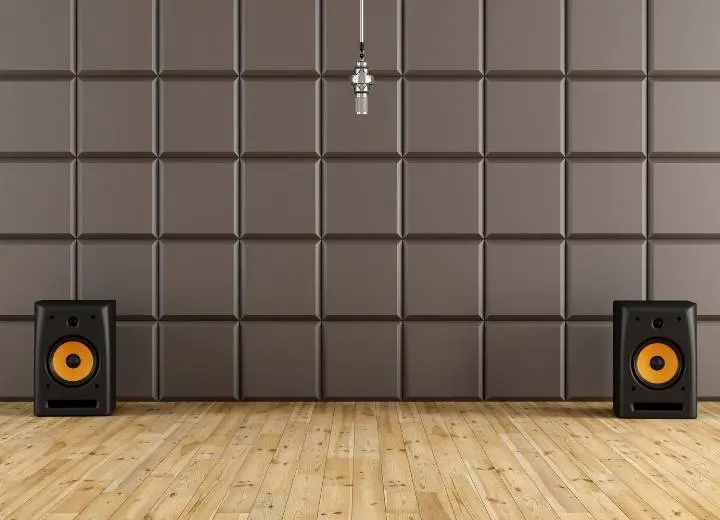
One of the most crucial stages in separating your recording studio from the other building is to install a floating floor. However, not many people know the proper process.
What is the method to build a floating floor for a recording studio? This article will give you comprehensive guidance to carry out the job. We will also include some tips to check your work.
Let’s read on to discover!
What Are Floating Floors?
You may install a floor for your recording studio in one of three ways: glue down, nail down, and floating. What kind of flooring is best for a recording studio?
Floating floors differ from other forms of flooring in that they do not require glue or nails to adhere to the substrate.
Floating floors are a type of hard flooring. It lies without the need of nails or glue. The term “floating flooring” refers to the technique of installation rather than the floor itself.
This sort of hardwood flooring works with a system of grooves and tongues. It allows each section to connect without the need of any actual fasteners.
Many people find installing the floating floor convenient. It is extremely flexible because of its variety of materials and styles. You can consider the following three types of floating floors:
#1. Engineered Wood
Engineered wood flooring is a type of hybrid wood. It combines with a decorative outer surface bonded over a plywood core.
This kind of flooring is a great alternative to genuine hardwood if you don’t want to utilize it.
#2. Laminate
Laminate flooring is another option for a floating floor. Laminate flooring is a layered synthetic flooring for a sophisticated and elegant look.
Laminate flooring is just a type of composite flooring. They are extremely long-lasting and ideal for a busy household.
#3. Luxury Vinyl
LVF holds the boards together in the same manner as laminate boards do. LVF’s boards come from small tongues and grooves. These materials allow them to lock properly. Some LVF is semi-flexible, while others are stiff.
How To Build A Floating Floor For A Recording Studio?
This video shows you how to build a floating floor for a recording studio in detail
You can also follow the steps below to carry out the job properly:
Step 1: Cut the padding
Cut the neoprene padding into two by 2-inch squares. Remember to use tin snips to cut.
Step 2: Calculate the flooring’s thickness
Calculate the total thickness of the flooring you’ll be placing on top of the pads. This is to determine the number of stacks you may need for the floor.
To begin, measure the room to calculate its square footage.
Then figure out how much drywall, plywood, and underlay weigh.
To get the overall weight of your floor, multiply the weight per sq foot of the flooring layers. After that, divide the sum by 15 to split the material at 15 pounds for each stack. This will tell you how many stacks you will need in total.
Alternatively, you may utilize additional stacks and position them one per foot. The flooring will become slightly less effective as a result. Yet, most users will not feel a change.
Step 3: Apply the pads with cement
Stack three pads together and secure them with cement. Cleaning the pads before applying the cement will aid in its adhesion. Ensure that you have enough stacks to support the whole floor.
Step 4: Lay the stacks and insulation on the floor
Lay the stacks on the flooring at the desired location. Try to place them evenly and isolate the stacks with insulation.
Then, place the insulation on the floor. It should be under the stacks’ surface so that the flooring does not contact it.
Step 5: Lay the stacks on the plywood
Reduce the size of the initial layer of the plywood. It should cover the entire wall of the room. Lay the stacks on the plywood. It won’t be secured to the flooring in any manner.
Step 6: Apply the drywall
On the plywood, apply 5/8 inch drywall. Using screws to fasten the drywall to the plywood.
On drywall, add a layer of plywood. To attach the plywood to the drywall sheet, place some screws in the margins.
Step 7: Lay the wooden flooring
On the floating floor, place a wooden flooring. You can use any form of hardwood to finish the floating floor.
How To Check The Floating Floor?
First, check the floorboard attachment. Examine the nail heads or staple holes on the floor as another indicator that your floor is floating. You most likely have a wood floor rather than a floating floor if you discover any signs.
Another aspect to keep an eye out for is the floor’s grain. That is to say, the grain pattern of each floating board will be identical. It will never duplicate itself if you have real hardwood floors.
Some of the planks on costly floating flooring contain variances. Nonetheless, there would be some patterns that fit.
So, don’t quit up until you’ve checked a big section of the floor for the match pattern. Also, look for dents and scrapes on the floor. Hardwood flooring is more susceptible to damage than floating one.
Conclusion
Now you may know how to build a floating floor for a recording studio. Remember to check the floor after finishing your job.
Have we missed something? If you need any further information, please feel free to comment. We will be right back to assist you.
Hopefully, you find this article helpful. Thank you for reading.
